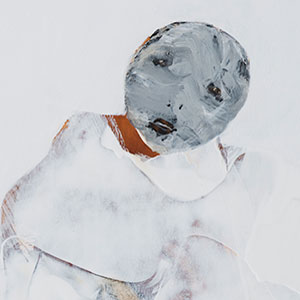Arts
Marianne Kolb's Eerie Truths at Triton
 'No. 1' from the series 'The White Paintings' by Marianne Kolb.
'No. 1' from the series 'The White Paintings' by Marianne Kolb.
On the path that leads to Marianne Kolb's studio, two female mannequins stand with their arms akimbo. These approximate women are unclothed in that disconcerting nude color that's meant to mimic caucasian skin. Their lips are painted red, their eyes are staring up at something that makes them smile.
They aren't Kolb's muses—real people are, the ones she meets on her daily walks—but they do point toward the den of an offbeat imagination that's expressing itself in acrylic paint, gesso and rust.
The varnish on a dozen of her recent paintings has finished drying. They're lined up on the studio floor leaning against every wall. Some, but not all, of them will make it into her upcoming show at the Triton Museum but the curator hasn't made the final selections. Kolb might be revealing a favorite when she picks up a white plastic bottle cap. She approaches the canvas to demonstrate the way she created the circular pattern and texture of the figure's dress. Like many of Kolb's paintings in this series, "Nadia" stands in the middle of the frame, solitary and hairless with her hands tucked inside her dress pockets. Patches of her forearms hang closely at her side.
Anatomically speaking, the proportions are incorrect. Nadia's head is two sizes too small for her body and doesn't fit correctly upon the neck. The skin color is crepuscular, an unhealthy combination of blues and grays. But Kolb isn't painting a representational portrait. Her aim, she says, is to go "straight to the essence" of the person she's painting, the way that Giacomo Giacometti did (a photograph of the Swiss artist hangs on her wall). Nor does she include any extraneous details, nothing but a solid color background. She feels that "a lot of artists, they need to put something in to anchor the figure. So they put a window in it or a chair." But Kolb embraces that "so-called emptiness" in the background. "Just give me the figure," she says.
During the fall of 2001, shortly after 9/11, Kolb had an exhibit at the Richmond Art Center. In retrospect, her "Monk Series" displayed back then looks prescient. The faces are full of mortal anguish, shaped by scratches and erasures. The misshapen heads are alien, demonic, painted in sickly colors. They're slowly being consumed by the blue or green or brown backgrounds that are so profoundly dark you can mistake them for shades of midnight black. Whatever vision she had that inspired them also informs a newer series "The White Paintings."
"Nadia" and the paintings that are her companions stand tall at 61" x 48". "The White Paintings" are smaller, roughly 16" x 16". Even sitting on a side table, they're the most imposing works currently in her studio. The "Monk Series" offered Kolb's invention of Hell. The inversion of that—these white ones—is unearthly and spectral. If this is her idea of Heaven, it's just as disturbing. And yet, collectively they reveal a heretofore untapped majesty. She adorns the body in "No. 6" with a deflated Elizabethan collar, draping the chest and arms and torso in folds of splattered fabric. This could be a royal infant at a baptism or early coronation. But those deep blue lips and contusions could also suggest that the child is ready to be buried.
In this series, and a related one in which she experiments with gorgeous swaths of rust, Kolb has discovered a purer narrative form. She's adapted some of her earlier and messier lines that looked and felt like incomplete thoughts. Here her narratives tell whole, if eerie and imponderable, stories. Why does "No. 1" gaze so plaintively at the viewer? Is she wearing a kimono or a straitjacket, or a hybrid of them both sewn together? And that band of red at the collar—is it blood or dyed silk?
"No. 4" has doubtless risen from the dead. Her dress is a fraying, translucent shroud. Is she back for something more than a haunting? Kolb doesn't answer that question. However, she does say that she's "giving enough so that the person who looks at them can bring their own stuff to it, that it resonates with something in them, and then they can make up their own story."
Marianne Kolb
May 12 - Aug 5
Triton Museum of Art
tritonmuseum.org


